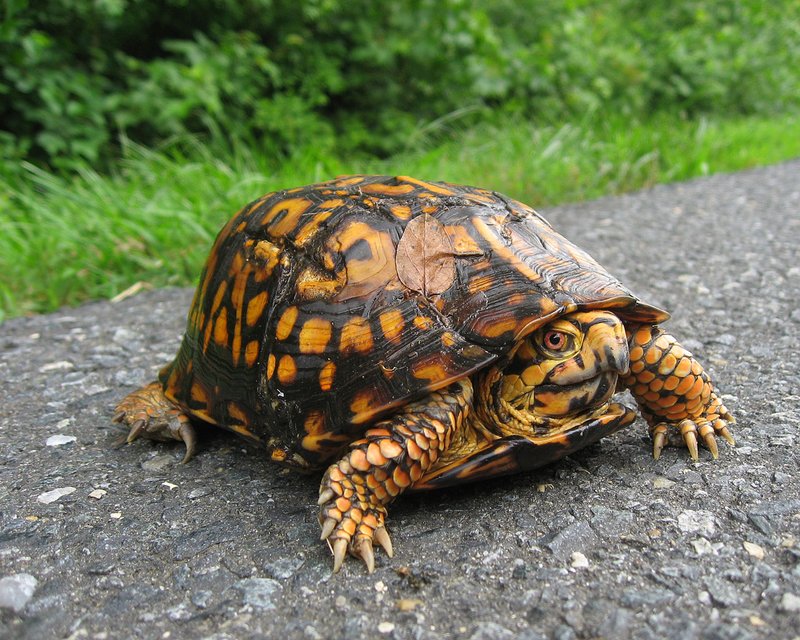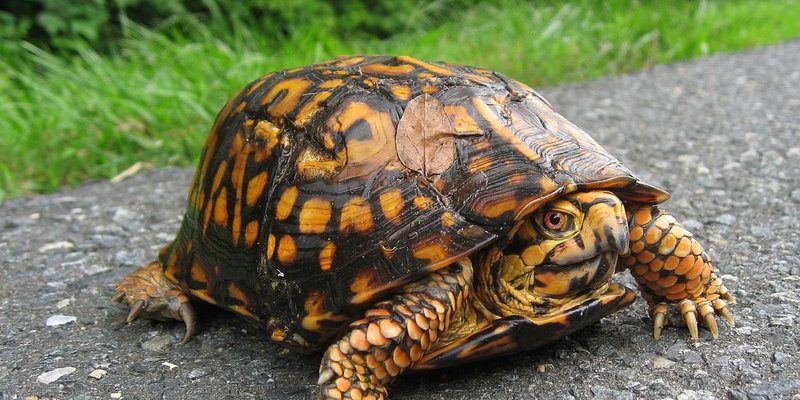
Imagine them as little adventurers with a suitcase on their backs, ready to explore the world but always returning to their beloved habitats. Box turtles are not just confined to one region; they have adapted to many environments. So, let’s take a closer look at the different places where box turtles thrive and what makes each location special.
North America: The Heart of Box Turtle Country
One of the most significant habitats for box turtles is the United States. Here, they can be found in various environments, from woodlands to grasslands. The Eastern Box Turtle (Terrapene carolina carolina) is particularly common in the eastern states, where it enjoys moist forests and fields. These turtles are most active during the warm months, often seen basking in the sun or foraging for food like berries and insects.
In the central and southern regions of the U.S., you’ll also find the Three-Toed Box Turtle (Terrapene carolina triunguis) and the Gulf Coast Box Turtle (Terrapene carolina major). The Three-Toed Box Turtle has a unique adaptation—its three toes on the back feet! They thrive in sandy or loamy soils, often near water sources like ponds and streams. These turtles are quite social too, often seen interacting with each other, adding a layer of community to their quiet lives.
The habitats in North America vary widely, which allows box turtles to adapt in different ways. For instance, while some prefer the dense shade of forests, others might enjoy the sun-drenched fields. This adaptability is a testament to their resilience and resourcefulness.
Mexico: A Diverse Habitat
Traveling south, we find box turtles also inhabiting parts of Mexico. Here, you can spot the Mexican Box Turtle (Terrapene carolina mexicana). It thrives in a variety of ecosystems, including arid regions, forests, and even montane areas. Imagine them roaming around the vibrant landscapes, blending seamlessly with the colorful flora and fauna.
These box turtles often seek out moist environments, particularly during the dry seasons when they can be a bit harder to find. They typically prefer areas with plenty of cover, such as shrubs and underbrush, which provide both food sources and protection from predators.
Interestingly, the warmth and sunlight of Mexico’s climate allow these turtles to thrive year-round, unlike their northern cousins, who might hibernate during harsh winters. This allows for a unique lifestyle where they can be more visible to observers and researchers.
Central and South America: A Lesser-Known Home
Box turtles don’t stop at Mexico; they can also be found in parts of Central and South America. The Central American Box Turtle (Terrapene carolina venusta) is primarily found in countries like Guatemala and Honduras. These turtles prefer lush, tropical forests where they can find ample food and shelter.
In South America, the environments vary widely, from dense jungles to open savannas. Some species of box turtles have adapted to these environments remarkably well, demonstrating their versatility. The warm, humid climates provide a perfect backdrop for their active lifestyle.
Here’s the thing: the diversity of ecosystems in Central and South America offers a unique perspective on how box turtles can adapt and thrive. Whether it’s in the thick underbrush or near water bodies, these turtles show us just how resilient they can be.
Asia: A Surprising Encounter
It may surprise you, but box turtles also have a presence in Asia. Certain species, like the Asian Box Turtle (Cuora) can be found in various parts of Southeast Asia. These turtles often inhabit forests and wetlands, showcasing their adaptability to different environments.
The Asian Box Turtle has a unique appearance, often distinguished by its striking patterns and colors. These turtles are a bit more elusive, often preferring dense vegetation and water sources. Their habitats are critical for their survival, as they rely on both land and aquatic environments for food and shelter.
Conservation efforts in these areas are increasingly important. As their habitats face threats due to urbanization and deforestation, understanding where they live can help protect these valuable ecosystems.
Conservation Status and Habitat Protection
The various habitats where box turtles are found are not just homes; they are vital ecosystems that need protection. Many species of box turtles are threatened or endangered due to habitat loss, climate change, and pet trade.
Protecting these habitats involves a combination of conservation efforts, such as creating reserves and implementing laws to protect these unique turtles. It’s essential for communities to work together to preserve the environments where box turtles live, ensuring they can thrive for generations to come.
Here’s where you come in: If you want to help, you can support local wildlife organizations or even educate others about the importance of preserving these precious habitats. Every little effort counts.
Why Understanding Their Habitats Matters
You might be wondering why it’s important to know where box turtles are found. Understanding their habitats not only helps with conservation efforts but also enriches our appreciation for these incredible creatures. By knowing where they live, we can better understand their needs and behaviors.
Additionally, this knowledge can influence how we protect them. For instance, if we know that box turtles thrive in certain types of environments, we can work to conserve those areas. It’s a relationship built on respect and understanding.
Connecting with nature through understanding where box turtles are found can foster a sense of responsibility to preserve these environments. It reminds us that we share our planet with many incredible species that deserve our care.
Final Thoughts
Box turtles are more than just charming little creatures; they are a symbol of resilience and adaptation. From the forests of North America to the tropical climates of Central America and beyond, these turtles remind us of the beauty and diversity of our world.
By learning about where box turtles are found, we can foster a deeper appreciation for their habitats and the importance of conservation efforts. So next time you see a box turtle, whether in the wild or in a photograph, think of the journey it has taken to get there and the environments it calls home. Together, we can ensure that these wonderful creatures continue to thrive in their natural habitats.

